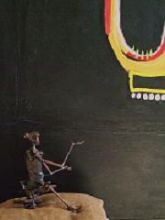Minder stupid
Regisseuse Franny Armstrong over de eerste milieuverantwoorde film.
 “We hebben alles uit de kast gehaald om onze ecologische voetafdruk te beperken”. De Britse Franny Armstrong benadrukt het nog maar eens: “Ik ben filmmaakster, maar bovenal milieuactivist.”
“We hebben alles uit de kast gehaald om onze ecologische voetafdruk te beperken”. De Britse Franny Armstrong benadrukt het nog maar eens: “Ik ben filmmaakster, maar bovenal milieuactivist.”
Armstrong is het brein achter de klimaatrampenfilm The Age of Stupid, die in september 2009 in 64 landen tegelijk in première ging. The Age of Stupid is een raamvertelling (verhalen–in-een-verhaal), die begint in 2055. De laatste man op aarde (Oscar-genomineerde Pete Postlethwaite) kijkt via digitale ‘archiefbeelden’ verbijsterd terug op onze collectieve onmacht om de allerwegen voorspelde klimaatcatastrofe te keren.
Die zogenaamde archieffilmpjes zijn feitelijk stukken klimaatdocumentaire, die Armstrong de afgelopen jaren heeft geschoten: zes persoonlijke levensverhalen van mensen in onder meer Nigeria, het Alpengebied en India.
Groene loper
 Hoewel gemengd ontvangen – de groene incrowd was euforisch, nuchtere filmcritici minder – markeert The Age of Stupid een nieuw geluid in de filmwereld: voor het eerst werd bij de productie consequent op alle milieuaspecten gelet.
Hoewel gemengd ontvangen – de groene incrowd was euforisch, nuchtere filmcritici minder – markeert The Age of Stupid een nieuw geluid in de filmwereld: voor het eerst werd bij de productie consequent op alle milieuaspecten gelet.
De wereldpremière was een wereldwijd uitgezonden groen spektakel. De première-tent in New York draaide op zonneënergie. De celebs arriveerden met schone voertuigen bij de ‘groene loper’. Belangrijker was dat Franny Armstrong iets deed wat nog niemand voor haar had aangedurfd: in de titelrol keurignetjes uitrekenen hoezeer de filmproductie het milieu precies had belast.
Grootvervuiler
Je staat er niet zo bij stil, maar de filmindustrie is een grootvervuiler, en dan vooral de filmproductie zelf. Ga maar na: duizenden decorstukken, supersterke lampen, vliegreizen en sloten chemicaliën voor het ontwikkelen van duizenden kilometers film. Maar ook in Hollywood heeft ‘eco’ toegeslagen. Europa, Bollywood in India en Nigeria zijn nog niet ontwaakt, maar de Australische en Britse filmbranche gaan eveneens op groen.
Zonder grote lampen
De milieuthriller The Day after Tomorrow uit 2004 geldt als de eerste ‘klimaatneutrale’ Hollywoodfilm. Maar dat was alleen omdat de CO2–uitstoot ‘gecompenseerd’ werd door bosaanplant en andere milieumaatregelen.
“Wij hadden het gemakkelijker”, beseft Armstrong: “Bij ons was het speelfilm-element beperkt. Het merendeel is documentaire. Documentaireteams zijn klein en werken niet met rolfilm, maar digitaal. Ook konden wij alles af zonder grote lampen, met natuurlijk licht.”
Alleen openbaar vervoer
Met strenge hand leidde Armstrong haar team naar een totale ‘CO2-voetafdruk’ van 94 ton. Nog altijd indrukwekkend, maar toch een schijntje vergeleken met de 10.000 ton voor een gemiddelde Hollywoodprent. Zie ook: www.ageofstupid.net en www.notstupid.org
“Door in verre landen plaatselijke crews te gebruiken, bespaarden we reiskilometers. Verder reisden we alleen als het moest, en alleen met openbaar vervoer. Eén keer heeft dat discussie gegeven. We moesten naar de Alpen. Per vliegtuig kon dat voor een paar tientjes, maar treinkaartje gingen ons budget aanvankelijk te boven, maar één van onze honderden privé geldschieters heeft dat bijgepast.”
Martial Art

Once they were bullets, pistols or grenades. Now under the deft hands of Mozambique’s possibly most famous sculptor Goncalo Mabunda they have been transformed into Art.
Recycling AK-47's and other arms from the one-time civil war has become the trade mark of Mabunda and a couple of his fellow artists. I saw some of the results in a small B&B in Antwerp. But even the British Museum and the Bill Clinton Foundation acquired pieces from the 'Arms into Art' programme. Read more…
Photo: © Michel Robles
High on FSC

Ten years ago the Netherlands were an admired environmental pioneer nation. Nowadays, due to a shortsighted neoliberal policy we are almost tail-end Charley within the European Union. Belgium, on the other hand, is a real runner-up. Last December (2010) the Flemish Leukenheide distillery presented Dennenknopje (Pine Bud). Dennenknopje is the world’s very first jenever (traditionally a truly Dutch strong drink), made from a Forest Stewardship Council (FSC) labeled wood product. The gin-like softbooze is distilled from pine cones from the Pinus silvestris. The pines grow in Flanders’ vastest, FSC certified forest region Bosland. A local high from an okay forest. Innovation can be anywhere.…
Questioning Plastiki pride
The newly designed cradle-to-cradle catamaran Plastiki has recently arrived is Sidney after a publicity voyage from California across the Pacific Ocean. The designers claim extreme recyclability. But, contrary to earlier announcements, the ship will not be up-cycled now that it has reached its destination. The builders say they've become too attached to their newborn baby. Of course, the vessel can be a showcase for years to come. But, hey, isn't this kind of attachment of people to their achievements precisely the reason why our earth is becoming such a cluttered place? www.theplastiki.com

Sweet C2C
Cradle-to-cradle handmade beauty: go haunt the town's antique and recycle shops and flea markets for a bunch of elegant (or maybe you prefer funny or modern design) plates, saucers and wine glasses. Wash them well, sand the glasses' brims lightly and glue things together with strong porcelain glue. Any shape, size and design you fancy, will do.


Lo and behold: you have now created your own home grown bonbonnière! For sweets, cookies, fruit - or sandwiches if you like. Ladies love'em! Dozens were sold in a fashion shop in my home town. Enjoy more...

Photos: © Michel Robles
Links
Novio Design Webdesign
